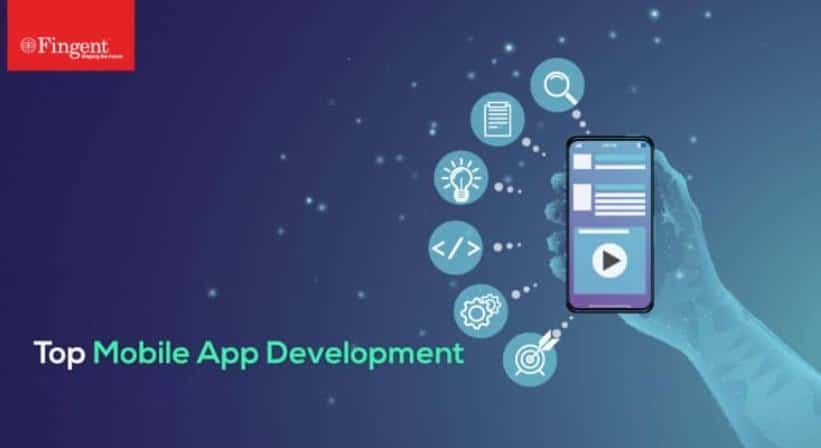Table of Contents
- End-to-end Mobile Application Testing
- Top Trends in Mobile App Development
- How Custom Mobile Apps Help Grow Your Business
- The Cost to Develop a Mobile App
- Five Reasons Why Mobile Apps Fail and How to Prevent the Letdown
- Tips to Build Successful Mobile Apps
- Develop Your Mobile Application with Fingent
Introduction

What is Mobile Application Development?
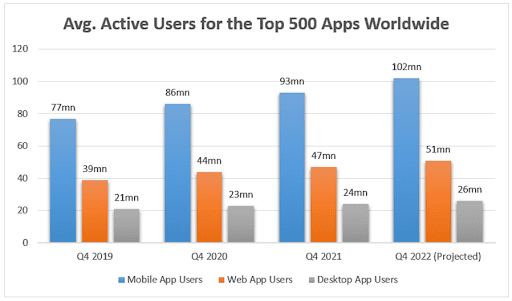
Top Mobile Application Development Platforms
1. Android
2. iOS
3. Hybrid
Mobile Application Development Approaches
1. Native Mobile Applications
2. Hybrid Mobile Applications
3. Cross-platform Mobile Applications
4. Progressive Web Applications
Top Mobile App Development Technologies
React Native offers a best-in-class JavaScript library for building native user interfaces for your iOS and Android apps, using a single code base that can be shared across all platforms. It allows developers to iterate at lightning speed and create truly native apps without compromising your user experiences.
This software is distributed freely to the users on a trial basis, usually with a limited-time offer. After that, the users are expected to pay if they want to continue to use this application software. Some examples of shareware are WinZip, SnapTouch, and Adobe Acrobat.
Xamarin is an open-source mobile app platform for the .NET which offers tools and libraries specifically for building apps for Android, iOS, tvOS, watchOS, macOS, and Windows.
If you are building something specific to Apple OS (native to Apple), Swift is the language to seek. Swift is a popular iOS application development language that offers advanced features with minimal coding that can be easily maintained. Swift is a powerful and intuitive language loved by Apple developers who use it for macOS, iOS, watchOS, tvOS, and so on.
Ionic is a modern, open-source mobile development framework that offers seamless app UX across iOS, Android, and the Web from a single shared codebase. Ionic is built on top of Angular JS and Apache Cordova. Ionic is the easiest way for web developers to build, grow, and scale cross-platform mobile apps.
Apache Cordova is a free and open-source mobile development framework that leverages HTML, CSS, and JS to target multiple platforms with one code base. The framework is an ideal choice if you want to extend your application across more than one platform, without having to re-implement it with each platform's language and tool set.
Sencha Ext JS is a highly comprehensive JS framework for building data-intensive, cross-platform web and mobile applications for any modern device. It offers numerous enterprise-ready tools, components, and libraries to create stunning mobile and web applications.
Mobile Application Development Process
Researching
Every app begins with an idea. However, your app can be successful only when the idea benefits your customers (app users). Ensure that your analysis includes the demographics, motivations, and behavior patterns of your buyers.Wireframing
Drawing a detailed sketch of the envisioned product helps you uncover the usability issues of your app. After sketching, wireframing helps refine your idea and organize all the essential components.Assessing Technical Feasibility
Asking questions, brainstorming ideas, and reviewing the status allow your team to decide the initial functionality’s feasibility.Prototyping
Creating working prototypes or mockups of your application allows you to verify if your development process is moving in the right direction. Prototyping enables different stakeholders to have a first look at your app and validate the information you have gathered.Designing
Create multiple variations of the screen. A clear visual direction helps you visualize the final product.Developing
This is the core phase of the application development process, where you actually develop the mobile app.Testing
The app is delivered to the potential users to test its user experience. Their feedback and opinions will help you add what your app lacks from their point of view.Launching
Publish your app to the app store. Plan regular app maintenance to fix bugs and enhance user experience.Mobile Application Front-End and Back-End

End-to-end Mobile Application Testing
- Step 1 : A developer must outline the list of all the cases and create a test plan.
- Step 2 : Decide whether the test will be manual or automated.
- Step 3 : Define test cases for different functionalities.
- Step 4 : Begin with exploratory testing as it does not require any initial investment.
- Step 5 : After detecting the patterns of outcomes and their frequency, consider automating the predictable ones.
- Step 6 : Start the sprint with usability and beta testing.
- Step 7 : Assess the performance of the entire system.
- Step 8 : Conduct security and compliance tests to deal with exceptions and unpredictable situations.
- Step 9 : Launch the application to the app store and fix any issues post installation.
White Paper
Top Trends in Mobile App Development
New research indicates that the global mobile application development platforms market is expected to reach $44.3 trillion by 2027. Technology advancements, growing consumer demands, and several other factors directly influence the mobile app development process today. Here are the top five mobile app development trends that will dominate 2022.
1. Native Mobile Applications
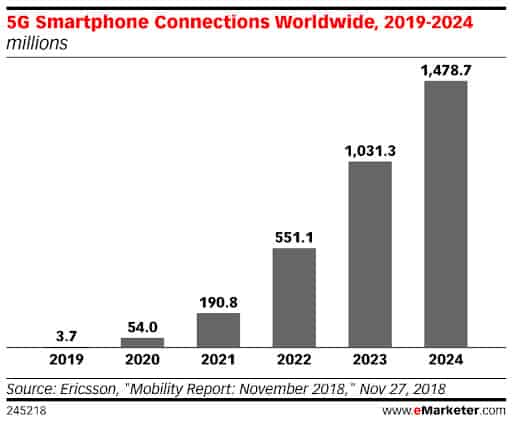
2. Augmented Reality (AR) and Virtual Reality (VR)
The use cases for AR in mobile apps is continuing its upward trend in 2022. By the end of 2024, the number of mobile AR users will reach 1.73 billion. AR is widely used by retailers, educational institutions, healthcare providers, workforce management teams, ecommerce companies, industrial manufacturing units, and other industries to create powerful mobile user experiences that help them gain a competitive edge.
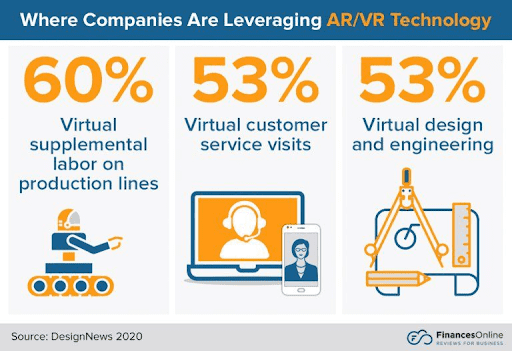
3. Low-code App Development
4. Mobile Commerce
According to Insider Intelligence, mcommerce volume in the United States is poised to increase from $128.4 billion in 2019 to $553.28 billion through 2024. The retail industry has reached a tipping point where a mobile app is a must for your business to stay competitive. Any single person or business selling online is ultimately trying to replicate the success model of ecommerce giants like Amazon. So, a mobile commerce app should be on the top of your list in 2022.
5. Predictive Analytics
How Custom Mobile Apps Help Grow Your Business
Improved Data Security
Custom mobile apps offer robust data protection against cyber-attacks by using additional configurations and measures, which off-the-shelf apps don’t provide. When you have a custom-built mobile app, your confidential data will not be available publicly. A unique security code and encryption are used to hack-proof your mobile application from any such attacks.Seamless Integration with Other Software
Most commercial, off-the-shelf mobile apps aren’t compatible with your existing business software, which can affect your productivity and performance. In contrast, you can make custom software integrate with all your current business applications quickly. Rapid and seamless integration of your custom mobile application with any third-party software makes it easy to manage your business operations.Highlight Your Competitive Advantage
A tailor-made mobile app with all the unique features that perfectly fit your business allows you to stay competitive. This is highly critical if you are offering a product or service with unique features and functionalities that your competitors are not offering. Custom software development will help you release an original application or platform that gives you a competitive advantage over similar players in your industry.High Scalability
Your mobile application should scale as your business grows. Only a highly scalable mobile app offers you the ability to handle rising demands, stay in track of the latest technology and market trends, and outgrow competitors in your business sector. It’s easy to add new capabilities or features to a custom mobile application without affecting its performance or leading to prolonged downtimes. Choosing a custom mobile app now will help you avoid scalability issues in the future.Long-term Support and Maintenance
Business growth warrants changes to your mobile application. When you use a boxed software, the quality of technical support and maintenance solely depends on the software provider’s policies, availability, and capability. A custom mobile app frees your business from such restrictions by offering dedicated support to enhance, customize, maintain, and scale your app. Tailored software allows your business to grow while improving and evolving your application in the required direction and measures.The Cost to Develop a Mobile App
1. Features of The App
2. Different Devices and Platforms
3. Native or Cross-platform Development
4. In-house Development or Outsourcing
More insights on mobile app development cost:
Five Reasons Why Mobile Apps Fail and How to Prevent the Letdown
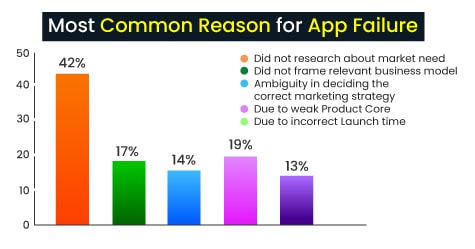
1. Lack of Market Research
2. Absence of a Robust Mobile Strategy
- What is my mobile app’s selling point?
- What features should I incorporate?
- What benefits will my app offer the user that my competitors don’t?
3. Poor App Design
4. Failure to Execute the Plan Precisely
- Have an original idea to offer value to your customers
- Work with people you trust. Discuss your challenges with your mobile app development partner if you are outsourcing.
- Have a conservative budget that is well planned and generously funded
5. Failure to Market Your App
- Have a crystal clear marketing message that nails your target audience
- Deliver your message through the right channels
- Focus on the solution
- Help the customer realize how they can benefit from your product or service
- Depending on your financial situation, offer discounts and other perks to attract more users
Tips to Build Successful Mobile Apps
According to a report from data.ai, the global app downloads reached 37 billion in the first quarter of 2022, with the biggest ever consumer spending on apps hitting a whopping $33 billion. The message is clear. There is hope for every mobile app. Here are three important tips to help you approach app building with confidence.
- Be agile, but know your limits:
- Know the risks:
- Build trust:
